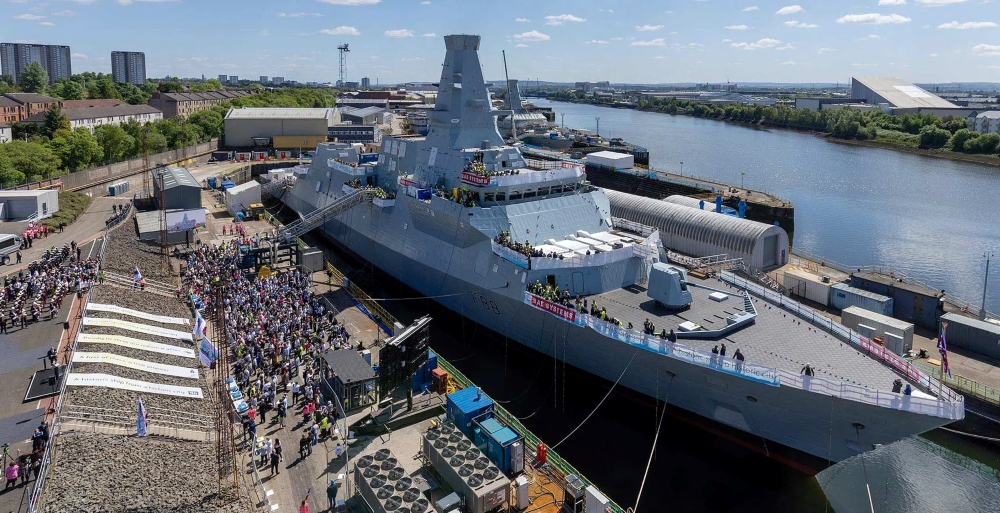
On May 22nd, the first ASW TYPE 26 frigate was officially named HMS GLASGOW by its sponsor, the Princess of Wales, or more correctly since they were in Scotland, the Duchess of Rothesay, the correct Scottish title for heirs to the throne.
As per tradition, a bottle of Scottish whisky was used for the ceremony. The ceremony took place at the BAE Systems shipyard in Scotstoun, in the Glasgow area, where the units of this class are completed in dry dock after assembly at the Govan shipyard, a little over 3 km upstream along the River Clyde.
HMS GLASGOW is not yet ready to take to the sea, and work to complete the equipment will continue for a few more months. The first sea trials are expected later this year, with delivery to the Royal Navy in 2026. It is expected that a couple of years will be needed to complete all of the activities and trials associated with the first of its class that introduces several new solutions and systems, so full operational capability will only be achieved in 2028.
The name GLASGOW can boast 11 predecessors that go back to the 17th century and have accumulated 11 Battle Honours.
The TYPE 26, weighing approximately 8,000 tonnes, are units specialised in anti-submarine warfare and include multiple features to minimise their signature, particularly the acoustic one, to the extent that their hull appears to include a large anechoic area usually associated with their enemies, submarines. The armament consists of a BAE MK45 Mod 4 127/62 gun, 30 mm machine guns for close defence, 2 CIWS PHALANX 1B, 48 MBDA CAMM/SEA CEPTOR surface-to-air missiles, and 24 MK41 cells in which anti-ship and land-attack missiles from the Future Cruise and Anti-Ship Weapon project are planned to be embarked, as well as long-range ASW weapons expected to be developed by pairing the new STINGRAY Mod 2 torpedo under development with a rocket booster.
The future CARDIFF, second in the class, is also already at Scotstoun, while BELFAST and BIRMINGHAM are under assembly at Govan in the new covered structure called Janet Harvey Hall, recently completed. This covered structure allows the construction of 2 TYPE 26 side by side, sheltered from the Scottish weather. The final assembly of the blocks of GLASGOW and CARDIFF was previously carried out outdoors.
BAE Systems hopes for a bright future for the TYPE 26: after the selection of the design by Australia and Canada, which will however build their units at home, all eyes are on Norway, which is expected to announce its choice later this year. If the TYPE 26 wins, the Norwegian units will be built in Scotland. With an eye on Norway, BAE Systems has repeatedly shown the TYPE 26 armed with a battery of 16 Kongsberg NSM anti-ship missiles, which have also been adopted by the Royal Navy. It is not clear whether Her Majesty's Navy is interested in this enhancement; for now, the NSM are intended for the TYPE 23 and TYPE 45 and are, officially, a stop-gap solution.
In Rosyth, on the other side of Scotland, on May 27, the future HMS VENTURER also emerged into the sunlight. She is the first of 5 TYPE 31 or "Inspiration" class, composed of illustrious names from the history of the Royal Navy, associated with various TYPEs of units that have played key roles in naval warfare. The name VENTURER, specifically, was chosen to honour its direct predecessor, a World War II class V submarine that has the distinction of having, for the first and so far only time in history, torpedoed and destroyed an enemy submarine while both units were submerged. Babcock, which builds the TYPE 31 and owns the Rosyth shipyard, constructed in 2021 its own mega-covered structure, the VENTURER building, where the first TYPE 31 has already been assembled. Inside the hall there is also the second one (future HMS ACTIVE) already with the hull largely complete. During the roll-out of the VENTURER, the rapid progress of the third unit (future FORMIDABLE) became evident, with many blocks already constructed and ready to enter the VENTURER building. According to Babcock, the first blocks of the third unit would enter the hall "within hours" of ship one leaving. In fact, much of the yard is occupied by "parked" blocks waiting for their turn, testifying to the need for a new large shed to house the ship sections: Babcock has recently received permission to build one.
Within 10 days, the frigate will be loaded onto a submersible barge (already in position) for its entry into the water. It will then be taken inside Dry Dock number 3 at Rosyth where it will be completed with the funnels and masts and will receive its full electronic and weaponry fit, in a process that will take about 6 to 9 months, before the acceptance trials begin. Within 12 months, the unit should be in the hands of the Royal Navy. The original timelines have stretched, but with construction starting in 2022, they remain short, certainly much shorter than those for the TYPE 26: the first steel cut for the GLASGOW dates back to the now distant July 2017.
Babcock is already under contract for a substantial "Capability Insertion Period" that will see the TYPE 31s return to Rosyth for the insertion of more advanced combat capabilities than originally planned, particularly MK41 vertical launchers (up to 32 cells, pending official details). Initially, the TYPE 31, having been designed for fast and low-cost construction, would have had its missile armament focused solely on the CAMM/SEA CEPTOR. The TYPE 31 introduces into service with the Royal Navy the BAE-Bofors MK57 57 mm gun and the Mk4 40 mm guns (2 on each unit).
The "adaptable" ARROWHEAD 140/TYPE 31 design (which in turn descends from the Danish IVER HUITFELDT class design) has found success in Poland (3 units for the MIECZNIK project) and in Indonesia (2 units, Red-White Project) but Babcock hopes to prevail in other competitions, ideally with units to be built in Rosyth as well.








.png)
